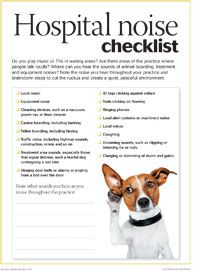Audit the audibles in your veterinary hospital
Does your practice sound scary to pets?

Sounds hold the power to affect pets' emotional, mental and physical wellbeing. And we can elevate or lower stress by the types of sounds in the environment. Offending noises can range from the music you play-and the volume-to speaking voices, animals boarding and being treated, equipment sounds and ambient noise in the room and surrounding areas.

First, recognize pets will be influenced by sounds they hear before they even reach your practice, including traffic noises, car sounds and more. Use the handout at dvm360.com/carnoise to help pet owners plan for quieter car trips to your practice.
Next, realize that while it's easy to grow accustomed to the noises around your practice, they still affect, even subliminally, the people and animals in your environment.
Tune in to sound
Join dogs and cats on their path through your veterinary practice, paying special attention to what they might hear, from sounds in the waiting room and exam room to the treatment area and kennels. Hitchhike on pet's exquisite senses of hearing by watching their ears and body language. The noises animals are exposed to may surprise you. Look for clues to what happened immediately before they swivel or lower or erect their ears. If they alert, flinch or flee, was it because of a noise you can identify?

Every hospital is different, but there are common triggers. Use the checklist at dvm360.com/hospitalnoise to help you audit the audibles around your practice.
Turn it down a notch
The good news: There are many options to minimize the outside noise upsetting pets. Remember the principle of calming noise to replace disturbing excess noise. Consider these options:
>Use calming music. Portable music devices allow you to play cat- and dog-friendly music in the hospital.
> Try some white noise, such as a white noise machine, a gentle fan or a water fountain.
>Place rolled towels under open spaces in doorways to muffle the outside noise.
>Consider insulated and sound-proofed pads if you're building or considering remodeling exam rooms.
>Replace phone ringing and loud alert systems. For example, you might use a headset with a personal alert or a phone with a vibrate or light up function or turn down the volume. Keep personal phones on silent mode.
Build a place for healing
Minimizing scary vocal sounds promotes rest for your patients. Animals who are attempting to rest, sleep and recover in an environment with so many things going on are easily disturbed by loud noises, including talk. So be aware of human sounds-not just during your interaction with the pet-but at other times as well. Even surgery, lunch time or talking with a client over the phone affects nearby animals. If an especially loud or startling sound happens-for example, you yell a message to a team member from the front office to the back office-the animals nearby are likely to freeze or jump.
>
Use your “inside” voice.
Tactfully approach any loud and booming talkers in your practice. Remember, you don't need to remodel your practices as much as you must remodel your voice and handling techniques.
>Try a softer and predictably even voice with a soothing or upbeat and jolly tone instead of an abrupt, loud and boisterously booming voice. Ask pet owners if their dogs or cats have certain phrasing or tones they like most. For instance, perhaps the canine prefers a higher pitched and playfully silly tone. Or the pet owner shares a tone she uses when she's petting her kitty or calling the cat for mealtimes.
>Choose separation for “scary” sounding procedures, like trimming an area to prep for surgery. You may choose a separate room for these procedures or opt for a quieter clipper or setting if possible. Sometimes moving animals into other areas of the hospital, such as an outer kennel, helps if something potentially upsetting is about to happen, like when you need to use a power vac or a powered floor cleaner.
>Use a light touch when you close doors and gates. Try physically turning the handle or holding up slightly to shut gates in a quieter fashion. Or with latches, such as those on kennels, instead of letting them clang shut, hold up slightly on the latch while you open or secure it.
Continue to pay attention to the noises around your hospital, and you may discover new noise triggers, including shaking out a towel before laying it down, rather than gently unfolding it, or placing instruments down with a kerplunk on the table rather than carefully placing them. Awareness is the beginning of the process to de-noise-polluting your environment and instead filling it with calming sounds that mesh with your efforts for a Fear-Free experience.